Slippery Dick, Halichoeres bivittatus
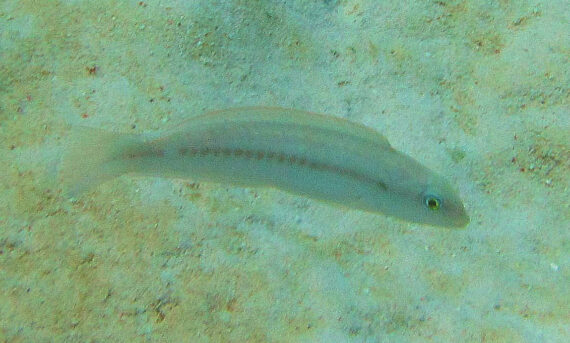 Slippery Dick, Halichoeres bivittatus, Initial Phase (IP), Female. Underwater photograph taken in the coastal waters of Bonaire, December 2019. Photograph and identification courtesy if Bob Hills, Ivins, Utah. Identification courtesy of Dr. Benjamin Victor, coralreeffish.com.
Slippery Dick, Halichoeres bivittatus, Initial Phase (IP), Female. Underwater photograph taken in the coastal waters of Bonaire, December 2019. Photograph and identification courtesy if Bob Hills, Ivins, Utah. Identification courtesy of Dr. Benjamin Victor, coralreeffish.com.
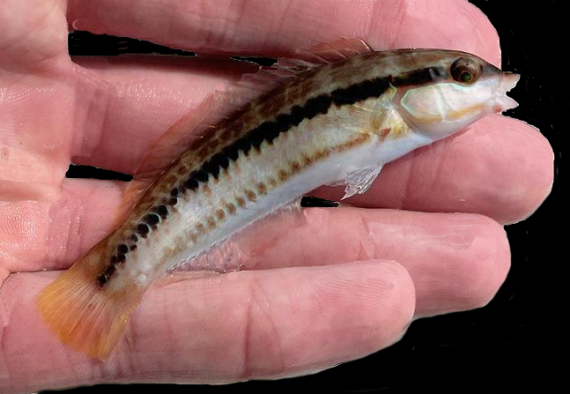 Slippery Dick, Halichoeres bivittatus, Initial Phase (IP), Female. Fish caught from coastal waters off Nassau, Bahamas, November 2022. Length: 8.1 cm (3.2 inches). Catch, photograph and identification courtesy of James Lafontaine, Long Island, New York.
Slippery Dick, Halichoeres bivittatus, Initial Phase (IP), Female. Fish caught from coastal waters off Nassau, Bahamas, November 2022. Length: 8.1 cm (3.2 inches). Catch, photograph and identification courtesy of James Lafontaine, Long Island, New York.
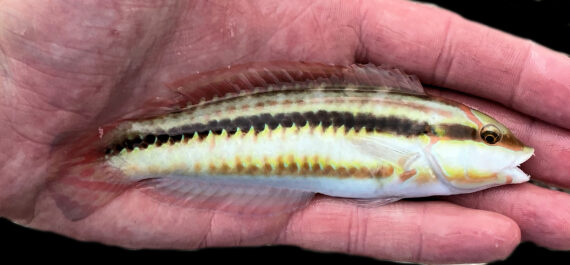 Slippery Dick, Halichoeres bivittatus, Initial Phase (IP), Female. Fish caught from coastal waters off Big Pine Key, Florida, April 2019. Length: 10.4 cm (4.1 inches). Catch, photograph and identification courtesy of Luke Ovgard, Klamath Falls, Oregon.
Slippery Dick, Halichoeres bivittatus, Initial Phase (IP), Female. Fish caught from coastal waters off Big Pine Key, Florida, April 2019. Length: 10.4 cm (4.1 inches). Catch, photograph and identification courtesy of Luke Ovgard, Klamath Falls, Oregon.
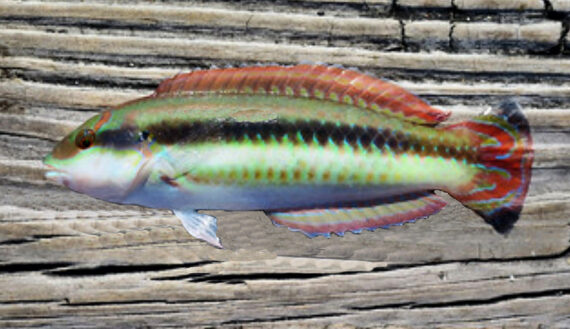 Slippery Dick, Halichoeres bivittatus, Initial Phase (IP), Female. Fish caught from coastal waters off Dania Beach, Florida, December 2015. Length: 15.0 cm (5.9 inches). Catch, photograph and identification courtesy of Eli (obsessiveangling.word-press.com).
Slippery Dick, Halichoeres bivittatus, Initial Phase (IP), Female. Fish caught from coastal waters off Dania Beach, Florida, December 2015. Length: 15.0 cm (5.9 inches). Catch, photograph and identification courtesy of Eli (obsessiveangling.word-press.com).
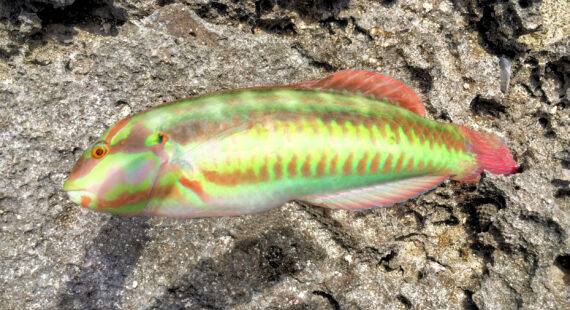 Slippery Dick, Halichoeres bivittatus, Terminal Phase (TP), Male. Fish caught Fish caught off the Dunedin Causeway, Dunedin, Florida, March 2010. Length: 12.5 cm (4.9 inches). Catch, photograph, and identification courtesy of Ryan Crutchfield, Tampa, Florida.
Slippery Dick, Halichoeres bivittatus, Terminal Phase (TP), Male. Fish caught Fish caught off the Dunedin Causeway, Dunedin, Florida, March 2010. Length: 12.5 cm (4.9 inches). Catch, photograph, and identification courtesy of Ryan Crutchfield, Tampa, Florida.
 Slippery Dick, Halichoeres bivittatus, Terminal Phase (TP), Male. Fish caught from coastal waters off Cozumel, Quintana Roo, May 2018. Length: 12.5 cm (4.9 inches). Catch, photograph, and identification courtesy of Ryan Crutchfield, Tampa, Florida.
Slippery Dick, Halichoeres bivittatus, Terminal Phase (TP), Male. Fish caught from coastal waters off Cozumel, Quintana Roo, May 2018. Length: 12.5 cm (4.9 inches). Catch, photograph, and identification courtesy of Ryan Crutchfield, Tampa, Florida.
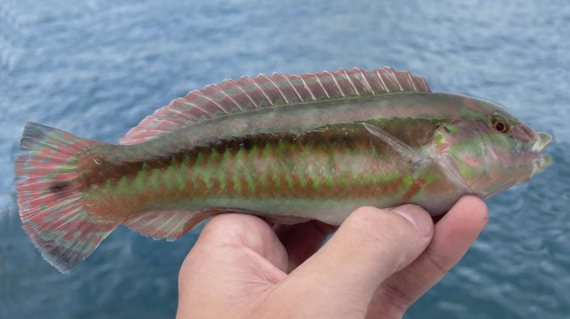 Slippery Dick, Halichoeres bivittatus, Terminal Phase (TP), Male. Fish caught from coastal waters off Nassau, Bahamas, November 2022. Length: 14 cm (5.5 inches). Catch, photograph and identification courtesy of James Lafontaine, Long Island, New York.
Slippery Dick, Halichoeres bivittatus, Terminal Phase (TP), Male. Fish caught from coastal waters off Nassau, Bahamas, November 2022. Length: 14 cm (5.5 inches). Catch, photograph and identification courtesy of James Lafontaine, Long Island, New York.
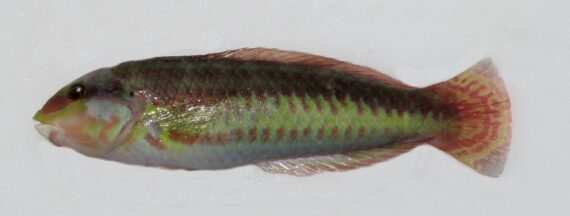 Slippery Dick, Halichoeres bivittatus, Terminal Phase (TP), Male. Fish caught from coastal waters off Sugarloaf Key, Florida, August 2014. Length: 16 cm (6.3 inches). Catch, photograph and identification courtesy of Dean Kimberly, Atlanta, Georgia.
Slippery Dick, Halichoeres bivittatus, Terminal Phase (TP), Male. Fish caught from coastal waters off Sugarloaf Key, Florida, August 2014. Length: 16 cm (6.3 inches). Catch, photograph and identification courtesy of Dean Kimberly, Atlanta, Georgia.
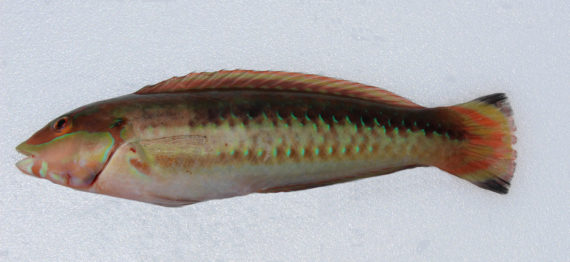 Slippery Dick, Halichoeres bivittatus, Terminal Phase (TP), Male. Fish caught from coastal waters off Key West, Florida, March 2017. Length: 18 cm (7.1 inches). Catch, photograph and identification courtesy of Dean Kimberly, Atlanta, Georgia.
Slippery Dick, Halichoeres bivittatus, Terminal Phase (TP), Male. Fish caught from coastal waters off Key West, Florida, March 2017. Length: 18 cm (7.1 inches). Catch, photograph and identification courtesy of Dean Kimberly, Atlanta, Georgia.
 Slippery Dick, Halichoeres bivittatus, Terminal Phase (TP), Male. Fish caught from coastal waters off Key Largo, Florida, December 2013. Length: 18 cm (7.1 inches). Catch, photograph and identification courtesy of Ben Cantrell, Peoria, Illinois.
Slippery Dick, Halichoeres bivittatus, Terminal Phase (TP), Male. Fish caught from coastal waters off Key Largo, Florida, December 2013. Length: 18 cm (7.1 inches). Catch, photograph and identification courtesy of Ben Cantrell, Peoria, Illinois.
The Slippery Dick, Halichoeres bivittatus, is a member of the Wrasse or Labridae Family, and is known in Mexico as doncella rayada. It is the most common wrasse of the Caribbean and received its colorful name many years ago from its body size, shape, and texture. Globally, there are seventy species in the genus Halichoeres, nineteen of which are found in Mexican waters, ten in the Atlantic and nine in the Pacific Ocean.
The Slippery Dick has an elongated cigar-shaped body with a depth that is 28% to 30% of standard length. They have three color phases. Juveniles are white with two dark stripes the lower of which is less pronounced. Females and males of the Initial Phase (IP) vary greatly in color from various shades of light purple to dark brown with a dark mid-body stripe that extends from the snout to the base of their tail and a second lower less distinct stripe. They have a small green and yellow bicolored spot above their pectoral fin and pinkish or orange markings on their head that are sometimes outlined in pale blue. Males of the Terminal Phase (TP) are various shades of green with similar striping as IP individuals but the tips of their caudal fin lobes are black. Their head is rounded with a blunt snout and is devoid of scales. They have one pair of enlarged canine teeth at the front of their upper jaw, two canines at the back of their lower jaw, and one small canine on the corner of their mouth. Their anal fin has 3 spines and 9 rays; their caudal fin is rounded; and, their dorsal fin has 9 spines and 11 rays. They have 16 to 18 gill rakers. Their body is covered with large scales. Their lateral line is continuous with an abrupt downward bend under the dorsal rays.
The Slippery Dick is found in shallow water within coral and rocky reefs and in seagrass beds at depths up to 15 m (50 feet). They reach a maximum of 35 cm (14 inches) in length. They are known to congregate and seek food where bottom disturbances occur. While swimming, they appear as if dragging their tail. They are omnivores feeding on brittle stars, crabs, fish, polychaetes, mollusks, and sea urchins. They are diandric protogynous hermaphrodites with males developing directly from juveniles or via the mid-life sex change of females. Leks or groups of males aggregate to attract females. Eggs and larvae are pelagic until they settle out on the sea floor. The Slippery Dick is poorly studied with very limited information available about their lifestyle and behavioral patterns including specific details on age, growth, longevity, movement patterns, diet, habitat use, and reproduction.
The Slippery Dick is found in all Mexican waters of the Atlantic Ocean including the Gulf of Mexico and the Caribbean.
The Slippery Dick is a fairly easy fish to identify due to the small green and yellow bicolored spot above its pectoral fin found in all three life stages.
From a conservation perspective the Slippery Dick is currently considered to be of Least Concern with stable, widely distributed populations. They are not a viable food fish but are used by the aquarium trade on a limited basis.